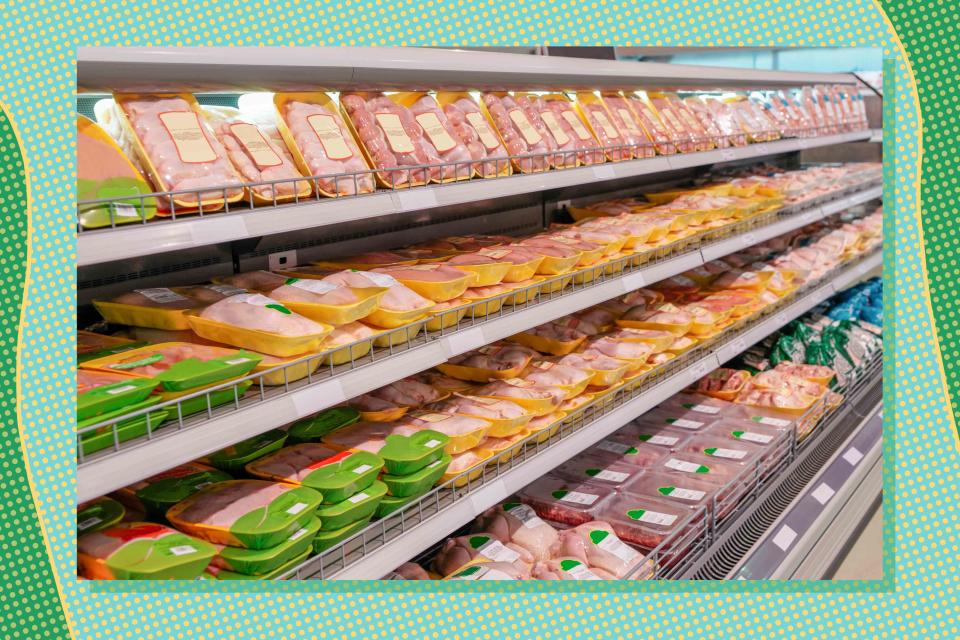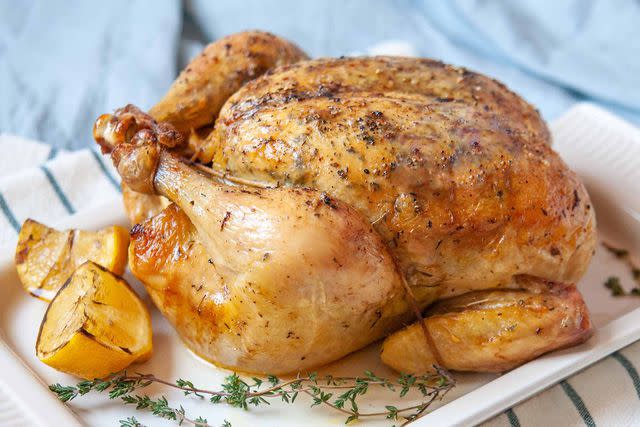5 Chicken Labels You Should Stop Paying Extra For, According to a Food Editor
Organic, all-natural, free-range, humanely raised, air-chilled, and more. How to decipher labels on fresh chicken and decide which ones are worth paying more for.

Simply Recipes / Photo Illustration Wanda Abraham / Getty Images
As a long-time food editor, I know well how popular chicken recipes are. In fact, chicken is the most consumed meat in the United States by a long shot, according to multiple sources, including the U.S. Department of Agriculture (USDA) and the National Chicken Council.
Though I buy chicken often because it's a dinner staple, I have to admit that I find all the different labels on the packaging confusing. Organic, all-natural, pasture-raised, humane—what do these even mean? And is it worth paying up for any of them?
I did a deep dive into the most common labels you may find on a package of fresh chicken to find out what they really mean and what they say about the chicken's living conditions, as well as the flavor, texture, and overall quality of the meat. Plus, which labels might be worth paying more for. Here's what I found.
5 Chicken Labels That Don’t Matter Much (Or at All)
These are the labels on packages of fresh or frozen whole chicken or chicken parts that I don't think are worth paying extra for. Here's why:
1. No Hormones or No Hormones Added
Added hormones are not allowed in the raising of chicken and other poultry in the United States, so this label is completely meaningless. If packagers choose to use it, they must include a statement on the label that says, "Federal regulations prohibit the use of hormones."
2. Natural
This USDA-regulated label means that the chicken contains no artificial ingredients or added color and was minimally processed. In addition, the label must include information about what is meant by natural—so the label might say "no artificial ingredients" or "minimally processed." While this label does give you some info about the chicken, some of the other labels below give more useful information about what's in the package.
3. Free-Range or Free-Roaming
To use this label, producers must demonstrate to the USDA that the chickens have been allowed to access the outside. However, this label doesn't necessarily mean an idyllic life for the chickens. It just means that the birds were given some access to an outdoor area of unspecified size, Greener Choices, a food safety and sustainability website, explains.
4. Cage-Free
No chickens raised for meat in the United States are kept in cages, so this label is simply touting the industry's minimum standard, according to Consumer Reports.
5. Vegetarian-Fed
This label means that no animal byproducts were fed to the chickens, which sounds like a good thing in theory. However, chickens are omnivores who forage and eat bugs, grubs, and even small animals like frogs, so a truly free-roaming chicken is not likely to be a vegetarian. Some experts argue that chickens that are allowed to forage for a wider diet in addition to the feed they are given are healthier themselves and healthier to eat. Also, a vegetarian-fed label doesn't tell you about the living conditions of the chicken.

Simply Recipes
6 Chicken Labels Worth Paying Up For
These labels are regulated by the USDA and/or actually indicate something about the quality of the product.
1. No Antibiotics Added or Raised Without Antibiotics
These labels mean that the chickens were not administered antibiotics. Antibiotic use in farming can contribute to antimicrobial resistance (AMR), a major health threat for humans. "In 2019, the World Health Organization declared AMR one of the top 10 global public health threats to humanity, and the United Nations estimated it could kill as many as 10 million people a year by 2050," according to Scientific American.
If possible look for the no antibiotics label in conjunction with the USDA Process Verified seal, which means that USDA inspectors have visited the farm to confirm the claims, according to Consumer Reports. Note that if you are buying certified organic chicken, there's no need to look for an additional "no antibiotics label."
2. Organic
Organic labeling is regulated by the USDA and producers must meet the following:
The farm must be certified
Chickens must eat 100% organic feed with no animal by-products, growth hormones, and genetically modified crops, and must not be administered antibiotics
The land on which the chickens are raised must also qualify for organic certification, which means among other things that certain pesticides are forbidden
Chickens must have outdoor access, but as with the free-range label, it does not mean they have continuous outdoor access
It's worth noting that many small farms do not have the resources for official organic certification, but meet the standards. Talk with the farmers at your local farmers market about their practices.
3. Non-GMO Project Verified
The Non-GMO Project is a nonprofit organization that administers a verification system to ensure that food is grown and raised without the use of genetically modified organisms. While chickens raised for meat in the United States are not genetically modified themselves, they might be fed GMO crops.
While there's much debate about the pros and cons of GMOs, if they concern you—for example, because they can lead to overuse of pesticides—this label is worth looking for. Beware that a generic "non-gmo" label is meaningless, according to Consumer Reports, so look for the Non-GMO Project Verified seal. Also, organic certification includes a ban on GMOs, so if you see the Certified Organic label, you're covered.
4. Animal Welfare Approved, Certified Humane, and Global Animal Partnership's Animal Welfare Certified
If you are concerned about the living conditions of chickens used for meat, the ASPCA recommends looking for labels from one of these three certifying programs, which they say are the most meaningful when it comes to the welfare of animals raised for food:
Certified Humane: The Certified Humane Raised and Handled label means that chickens have room to flap their wings and dust bathe; they must be given feed without growth hormones or antibiotics; and they must meet certain standards for humane slaughter.
Animal Welfare Approved: The Animal Welfare Approved label from the nonprofit A Greener World addresses "the most important expectations consumers have for a 'humane' claim," including outdoor access and freedom of movement, according to Consumer Reports.
Global Animal Partnership: The Global Animal Partnership has six levels of certification, ranging from a basic Animal Welfare Certified label, which includes things like minimum space requirements, to the top tier "Entire Life on Farm" label.
Note that a generic "humane" claim might not mean much, so if humane conditions from farm animals are important to you, it's worth seeking out these specific labels recommended by the ASPCA and other reputable groups.
5. Pasture-Raised
There's no federal standard for this label so on its own it's not reliable, according to the Environmental Working Group. However, used in conjunction with Animal Welfare Approved, Certified Humane, or Global Animal Partnership labels, this is a meaningful label that indicates the chickens have access to plenty of outdoor space. The ASPCA recommends looking for:
Certified Humane Raised & Handled + Pasture-Raised
Animal Welfare Certified + Pasture Raised (level 4) or Animal Centered (level 5) or Entire Life on Farm (level 6)
Animal Welfare Approved by AGW (while "pasture" is not in the label, it's folded into this certification)
6. Air-Chilled
After slaughter, much of the chicken you'll see at the grocery store is chilled in large vats of icy water, but air-chilled chicken is cooled down with cold air instead. This is a label I value because air-chilled chicken has a better texture and flavor than water-chilled. It soaks up marinades better and stays juicy but not soggy. According to D'Artagnan, a producer of air-chilled chicken, air chilling also means less chance for cross-contamination.
The Takeaway
There are certain labels like "no hormones" or "cage-free" that are meaningless. Other labels are worth seeking out, depending on your priorities. For me, those priorities include humane treatment of the animals and maximum tastiness.
So when I'm shopping for chicken at the grocery store, I look for one of the humane certifications recommended by the ASPCA, as well as an air-chilled label. That might mean I pay a bit more, but I'd rather eat the best chicken a little less often than lower-quality chicken. Now that you know what all those confusing labels mean, you can make the best chicken choice for you.
Read the original article on Simply Recipes.

